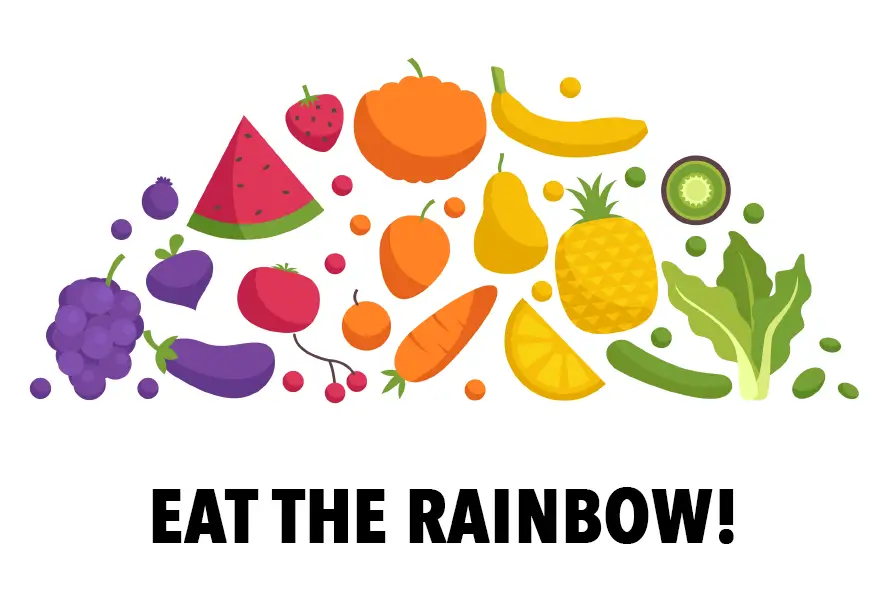
They say variety is the spice of life. That doesn’t just apply to experiences, it also applies to food! Eating various foods gives you the vital nutrients you need to fight diseases.
Fruits and veggies contain compounds called phytonutrients. Phytonutrients have the power to help your body fight diseases such as cancer, diabetes, and heart disease. They also help stimulate enzymes in the body that help boost the immune system, improve cardiovascular health, fight cancer cells, and promote the healthy metabolism of estrogen.
Phytonutrients are found in fruits and vegetables and legumes, seeds, nuts, whole grains, herbs, spices, and teas. Population studies show that cultures that eat a diet high in phytonutrients have lower incidences of grave diseases.
Dietary guidelines in the U.S. and nutritionists recommend eating a diet based on the rainbow. That means eating a variety of different colors every day. Here is a guideline for the color of the different foods and their health benefits.
The phytonutrient compounds found in red fruits and vegetables have many benefits that help you fight chronic diseases. The red category can offer the following benefits:
Anti-Cancer Boosts immune system
Cell protection Prostate health
Anti-inflammatory Vascular health
Some ways you can incorporate red foods are:
Adding tomatoes to salads
Salsa
Marinara sauce
Juices
Snack on red fruits like apples, raspberries, and strawberries
Orange foods are high in vitamin A, but there are many other beneficial properties in foods that are orange in color:
Skin Health Reproductive Health
Fights cancer Anti-bacterial
Cell health Boosts the immune system
You can incorporate orange foods by:
Making smoothies with mangos or papayas
Baking sweet potatoes
Eating carrots or drinking carrot juice for a snack
Putting orange slices in with your water.
Yellow foods have some of the same health benefits as orange and red foods. They help fight cancer and inflammation and are good for cellular health. Here are some added benefits of yellow foods:
Eye Health
Heart health
Vascular health
Cognition
You can incorporate yellow foods by:
Making ginger tea with fresh lemon
Adding yellow peppers to your cooking,
Adding corn to your dishes,
Use Yukon potatoes instead of russet and
Have some slices of pineapple for breakfast or dessert
The green food varieties are also antioxidant and anti-inflammatory. They aid in heart, brain, skin, and vascular health. Some additional benefits of green foods are:
Help liver function
Help balance hormones
Heart health
You can add green foods by:
Adding spinach to your omelet
Drinking green tea
Using green herbs like basil, dill, and oregano in your cooking
Make a green stirfry with bok choy, broccoli, edamame, and asparagus
This category is particularly good for brain health. Purple foods are especially effective for cognition, protecting the brain from damage, and memory. Ironically this color of food gets eaten the least. The main reason people tend not to eat as many purple fruits and vegetables is that there are not as many of them as there are yellow and orange. Here are some foods from this category that you might not realize have a lot of benefits.
Cabbage Purple carrots Olives
Grapes Blueberries Blackberries
Huckleberries Figs Raisins
Prunes Cauliflower Rice
It’s easy to incorporate purple foods into your diet:
Purple and blackberries make delicious smoothies and are good in waffles, pancakes, and in yogurt
Substitute white rice for purple or black rice
Snack on raisins, figs, or berries
Stirfry with purple veggies such as eggplant, carrots, and potatoes (all purple)
This category has the most variety of foods, including nuts, spices, legumes, seeds, and whole grains. When you think of white, get the processed white bread products out of your mind! These foods have the same compounds as green foods and are good for liver function and hormones. Another perk with foods in this category is they are good for digestive health. There are many foods in this category so here are examples:
Mushrooms Coconut Applesauce
Nuts Seeds Coffee
There are a variety of ways you can eat white, tan, and brown foods:
Hummus
Eating nuts as snacks
Eating beans and legumes (includes bean dip!)
Buying whole-grain foods
Using seed or nut butter
Eating a variety of foods is important for good health. You can get many of the nutrients you need from eating a wide variety of fruits and vegetables, along with nuts, seeds, legumes, and spices. By using the rainbow as a guide, you’ll be arming your body with compounds that help fight cancer, inflammation, and even Alzheimers disease. So, start experimenting with eating a variety of foods, and your body and brain will thank you!



